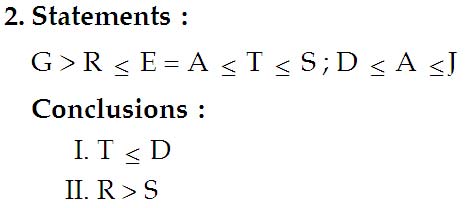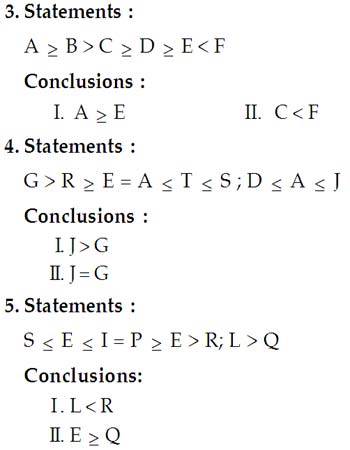(Papers) IBPS PO Exam Paper - 2016 "Reasoning Held on: 16-10-2016"

(Papers) IBPS PO Exam Paper - 2016 "Held on: 16-10-2016"
:: Reasoning Ability ::
Directions (1-5) : In these questions, relationship between different elements is shown in the statements. The statements are followed by conclusions. Study the conclusions based on the given statements and select the appropriate answer.
Give answer :
(1) If only conclusion II is true
(2) If only conclusion If is true
(3) If both conclusions I and II are true
(4) I f either conclusion I or II is true
(5) If neither conclusion I nor II is true
1. Statements :
S d” L d” I = P e” E > R ; L > Q
Conclusions :
I. P > S
II. I > R


Directions (6-10) Study the following information carefully and answer the questions given below.
Eight persons — H, I, J, K, L, M, N and O — are standing in a straight line
at equidistant. Some of them are facing north while others are facing south.
M is standing third to the right to H. M is standing at one of the extreme ends.
L is standing third to the left of H. The immediate neighbours of J. face north.
N is not an immediate neighbour of H.The persons standing at the extreme ends
face the same direction (both are facing either north or south). The immediate
neighbours of H face, just opposite direction as that of M. The immediate
neighbours of 0 face opposite direction with respect to each other.K is one of
the immediate neighbours of L and is facing north. I is standing between J and
M. Not more than four persons are facing north.L is immediate right of K.
6. Who among the following is third to the left of N?
(1) K
(2) J
(3) H
(4) I
(5) O
7. The immediate neighbours of L are :
(1) M and N
(2) N and O
(3) K and N
(4) N and H
(5) J and H
8. How many persons are standing exactly between I and 0 ?
(1) Three
(2) Four
(3) One
(4) Two
(5) None
9. Four of the following five are alike in a certain way based on the above arrangement and hence form a group. Which of the following does not belong to that group ?
(1) N
(2) L
(3) O
(4) J
(5) K
10. Who among the following is exactly between L and J ?
(1) N
(2) O
(3) H
(4) I
(5) None
Directions (11-15) : In each question below are given two/three statements followed by two conclusions numbered I and II. You have to take the given statements to be true even if they seem to be at variance with commonly known facts. Read all the conclusions and then decide which of the given conclusions logically follows from the given statements, disregarding commonly known facts. Give answer :
(1) If only conclusion I follows.
(2) If only conclusion II follows.
(3) If either conclusion I or II follows.
(4) If neither conclusion I nor II follows.
(5) If both conclusions I and II follow.
11. Statements :
All circles are a triangle.
Some triangles is rectangles.
All rectangles are squares.
Conclusions :
I. All rectangles being triangles is a possibility.
II. All circles being squares is a possibility.
12. Statements :
Some chairs are tables.
Some beds are tables.
No furniture is bed.
Conclusions :
I. All chairs being furniture is a possibility.
II. Some tables are not bed is a possibility.
13. Statements :
All circles are a triangle.
Some triangles are rectangles.
All rectangles are squares.
Conclusions :
I. Some triangles are not rectangles.
II. No square is a circle.
14. Statements :
All art are theatre.
Some art are dramas
Conclusions :
I. All dramas being theatre is a possibility.
II. Some dramas are theatre.
15. Statements :
Some chairs are tables.
Some beds are tables.
No furniture is bed.
Conclusions :
I. Some tables are not furniture.
II. All tables being furniture is a possibility.

DOWNLOAD IBPS PO Question Papers PDF
DOWNLOAD IBPS CLERK Question Papers PDF
Printed Study Material for IBPS PO Exam
IBPS PO (Probationary Officer) Exam Study Materials
Directions (16-18) : Read the given information carefully and answer the given questions.
B is 25 m south of A. C is 10 m east of B. D is 30 m north of C. E is 7 m east of D. X is 18 m south of E. M is 12 m south of X. C is 7 m west of M.
16. B is in which direction from Point D ?
(1) South
(2) South-West
(3) North-East
(4) South-East
(5) North
17. If Point W is 3 m to the north of A, then what is the distance between B and W ?
(1) 28 m
(2) 15 m
(3) 21 m
(4) 24 m
(5) 17 m
18. What is the distance between B and M?
(1) 17 m
(2) 15 m
(3) 21 m
(4) 19 m
(5) 13 m
Directions (19-33) : Study the following information to answer the given questions.
S, T, U, V, W, X, Y and Z are sitting in a straight line equidistant from
each other (but not necessarily in the same order). Some of them are facing
south while some are facing north.
(Note : Facing the same direction means, if one is facing north then the other
also faces north and vice-versa. Facing the opposite directions means, if one is
facing north then the other faces south and vice-versa)
S faces north. Only two people sit to the right of S. T sits third to the left
of S. Only one person sits between T and X. X sits to the immediate right of W.
Only one person sits between W and Z. Both the immediate neighbours of T face
the same direction. U sits third to the left of X. T faces the opposite
direction as S. Y does not sit at any of the extreme ends of the line. V faces
the same direction as W. Both Y and U face the opposite direction of Z.
19. How many persons in the given arrangement are facing North ?
(1) More than four
(2) Four
(3) One
(4) Three
(5) Two
20. Four of the following five are alike in a certain way, and so form a group. Which of the following does not belong to the group ?
(1) W, X
(2) Z, Y
(3) T, S
(4) T, Y
(5) V, U
21. What is the position of X with respect to Z?
(1) Second to the left
(2) Third to the right
(3) Third to the left
(4) Fifth to the right
(5) Second to the right
22. Who amongst the following sits exactly between Z and W ?
(1) T
(2) Y
(3) X
(4) W
(5) U
23. Who is sitting second to the right of T ?
(1) Z
(2) V
(3) X
(4) W
(5) None of these
Directions (24-26) : Study the following information and answer the given questions.
• D is daughter of N. E is wife of N.
• G is sister of D. C is married to G.
• N has no son. K is mother of E.
• Q is only daughter of C.
24. How Q is related to D ?
(1) Daughter
(2) Cousin
(3) Niece
(4) Sister-in-law
(5) Cannot be determined
25. How N is related to K ?
(1) Brother-in-law
(2) Cousin
(3) Son-in-law
(4) Sister
(5) Brother
26. How many daughters N have ?
(1) One
(2) Three
(3) Two
(4) Cannot be determined
(5) None of these
Directions (27-29) : Study the following information and answer the given questions.
There are six wires in a table A, B, C, D, E and F. They have different length but not necessarily in the same order. E is greater than C but less than D and B. A is greater than D and B. A is not longest wire. F is B cm long and E is 4 long.
27. If D is 5 cm less than F. what would be the length of D ?
(1) 7
(2) 8
(3) 9
(4) Cannot be determined
(5) None of these
28. Which wire has least length ?
(1) B
(2) A
(3) C
(4) E
(5) None of these
29. If A carry 10 cm length and B carry 5 cm. length then what would be the length of C?
(1) 6
(2) 2
(3) 7
(4) 9
(5) None of these
Directions (30-35) : Study the given information carefully to answer the given questions.
M, N, O, P, Q R and S are seven people live on seven different floors of a building but not necessarily in the same order. The lower most floor of the building is numbered 1, the one above that is numbered 2 and so on till the topmost floor is numbered 7. Each one of them have different income i.e., 3500, 15000, 7500, 9000, 11000, 13500 and 5000. (But not necessarily in the same order.) M lives on an odd numbered floor but not on the floor numbered 3. The one who has income of 11000 lives immediately above M. Only two people live between M and the one who has income of 7500. The one who has income of 15000 lives on one of the odd numbered floors above P. Only three people live between 0 and the one who has income of 15000. The one who has income of 7500 lives immediately above 0. R earns 4000 more than Q. The one who has income of 3500 lives immediately above the one who has income of 5000. S lives on an odd numbered floor. Only one person lives between N and Q. N lives on one of the floors above Q. Neither 0 nor M has income of 0000. Q does not has income of -500.
30. How much income M has ?
(1) 13500
(2) 5000
(3) 7500
(4) 15000
(5) 3500
31. Which of the following combinations is true with respect to the given arrangement?
(1) 13500 – 0
(2) 15000 – R
(3) 5000 – S
(4) 11000 – P
(5) 9000 – N
32. If all the people are made to sit in alphabetical order from top to bottom, the positions of how many people will remain unchanged ?
(1) Four
(2) None
(3) Two
(4) One
(5) Three
33. Which of the following statements is true with respect to the given arrangement ?
(1) The one who has income of 5000 lives immediately below M.
(2) R has income of 15000.
(3) None of the given options is true.
(4) Only four people live between P and S.
(5) S lives immediately below Q.
34. Who amongst the following lives on the floor numbered 2 ?
(1) N
(2) The one who has income of 3500
(3) The one who has income of 5000
(4) P
(5) R
35. How much income R has ?
(1) 13500
(2) 5000
(3) 7500
(4) 15000
(5) 3500
Answer Key
1. (3) 2. (2) 3. (1) 4. (5) 5. (5) 6. (2) 7. (3) 8. (4) 9. (5) 10. (2) 11. (5) 12. (5) 13. (1) 14. (5) 15. (4) 16. (2) 17. (1) 18. (1) 19. (2) 20. (4) 21. (2) 22. (1) 23. (2) 24. (3) 25. (3) 26. (3) 27. (2) 28. (3) 29. (2) 30. (4) 31. (1) 32. (3) 33. (3) 34. (5) 35. (3)
DOWNLOAD IBPS PO Question Papers PDF
DOWNLOAD IBPS CLERK Question Papers PDF
DOWNLOAD MORE BANK EXAMS E-BOOKS
Printed Study Material for IBPS PO Exam
IBPS PO (Probationary Officer) Exam Study Materials
Go Back to Main Page
